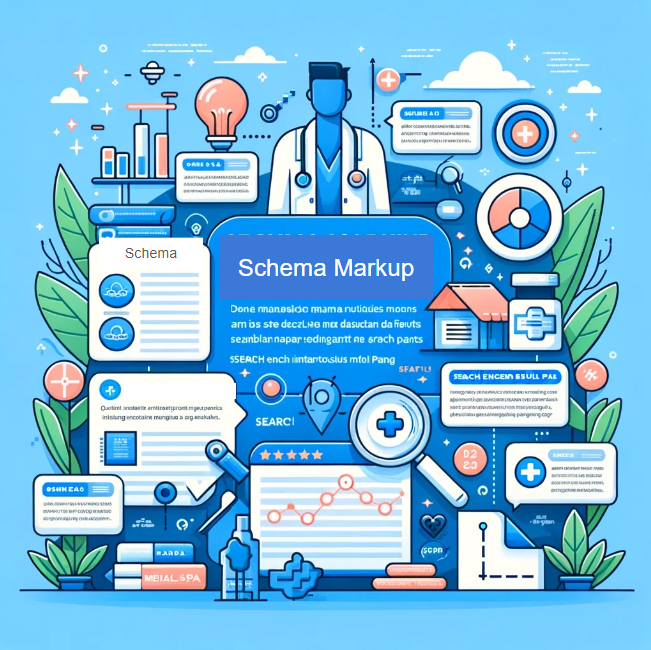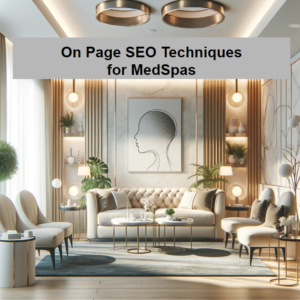Introduction
As more clients turn to search engines to find the best med spa services in their area, your visibility on these platforms can significantly influence your business’s success. This is where Search Engine Optimization (SEO) comes into play, particularly on page SEO techniques, which are crucial for improving your website’s ranking on search engines like Google.
On page SEO refers to the practice of optimizing web pages to earn organic traffic and improve a website’s rankings in the search engine results pages (SERPs). It involves aligning elements such as content, keywords, meta tags, images, and overall website structure with the best practices to make your site more attractive to search engines. For MedSpas, effective on page SEO is about ensuring that when potential clients search for spa services you offer, your website is one of the first they see.
This section of our broader “MedSpa SEO Strategies” pillar will dive deep into the on page SEO techniques tailored for medical spas. By implementing these strategies, you can not only enhance your website’s visibility but also ensure it resonates with your target audience, ultimately driving more booked appointments and elevating your business’s success in the digital realm.

Understanding On Page SEO
What is On Page SEO?
On page SEO is the cornerstone of any successful digital marketing strategy, particularly for medical spas seeking to enhance their online visibility. This practice involves optimizing various elements of your website, including content, HTML source code, and website architecture, to rank higher in search engine results and attract more relevant traffic. Unlike off-page SEO, which focuses on external signals like backlinks, on page SEO is all about what you can control directly on your website.
For MedSpas, on page SEO is not just about getting to the top of search results; it’s about ensuring potential clients find the right information, services, and value proposition your business offers at the moment they’re searching for it. A well-optimized website can help build your brand’s authority, drive engagement, and convert visitors into booked appointments.
Why is On Page SEO Essential for MedSpas?
In the highly competitive med spa industry, standing out in search engine results is crucial. On page SEO techniques help ensure that your website is not only visible but also appealing to both search engines and users. It’s about creating a seamless, engaging user experience that answers potential clients’ queries and encourages them to take action, such as booking a consultation or inquiring about a service.
Optimizing your med spa website with targeted keywords, relevant and high-quality content, and a user-friendly design improves your chances of ranking higher in SERPs. This visibility is essential in attracting a steady stream of potential clients actively looking for the services you offer.
Key On Page SEO Techniques for MedSpas
Website Structure and User Experience (UX)
A well-structured website is the backbone of effective on page SEO. For med spas, this means having a clear, intuitive navigation system that allows potential clients to easily find the information they’re looking for. A positive user experience (UX) is critical to keeping visitors on your site longer, reducing bounce rates, and encouraging them to explore your offerings.
- Navigation and Site Structure: Ensure your website has a logical hierarchy and clear navigation menus. Use breadcrumb navigation and a sitemap to help users and search engines understand and explore your site’s structure.
- Mobile Responsiveness: With the majority of searches now conducted on mobile devices, your website must perform flawlessly across all screen sizes. A mobile-friendly design not only improves UX but is also a ranking factor for search engines.
- Page Load Speed: Slow-loading pages can frustrate users and lead to higher bounce rates. Optimize images, leverage browser caching, and minimize HTTP requests to improve your site’s speed.
Content Quality and Relevance
Content is king in the realm of SEO, and this holds true for med spas as well. High-quality, relevant content that addresses your target audience’s needs and questions is essential for ranking well in search results.
- Engaging and Informative Content: Create content that provides value to your potential clients. This could include detailed descriptions of your services, blog posts on skincare tips, or answers to common questions about med spa treatments.
- Use of Keywords: Incorporate relevant keywords naturally throughout your content. This includes service-related terms, local keywords for geographical targeting, and long-tail keywords that match user search intent.
Let’s illustrate these concepts with a couple of images to visualize the impact of a well-structured, user-friendly med spa website and the importance of engaging, informative content.
Key Takeaways:
| Key Points | Solutions |
|---|---|
| Understanding On Page SEO | Focus on optimizing website elements directly to improve SERP rankings and user engagement. |
| Importance of On Page SEO for MedSpas | Enhances online visibility and attractiveness to both search engines and potential clients. |
| Website Structure and User Experience (UX) | Implement clear navigation, ensure mobile responsiveness, and optimize for fast page load times. |
| Content Quality and Relevance | Produce engaging, value-driven content that incorporates relevant keywords naturally. |
| Keyword Research and Optimization | Conduct thorough keyword research to find and utilize terms most relevant to your target audience. |
| Optimizing Meta Tags and Descriptions | Create compelling meta titles and descriptions to improve click-through rates from SERPs. |
| Image Optimization | Use relevant images with optimized file sizes and alt tags to enhance page load speed and accessibility. |
| Mobile Optimization | Ensure the website offers an excellent experience on mobile devices to cater to the majority of users. |
Key On Page SEO Techniques for MedSpas (Continued)

Keyword Research and Optimization
A cornerstone of effective on page SEO is keyword research. For MedSpas, identifying the right keywords involves understanding the services you offer, the queries your potential clients are using, and the language that resonates with them. Here’s how to conduct effective keyword research:
- Start with a Seed List: Identify the core terms related to your med spa services, such as “botox,” “facial treatments,” “laser hair removal,” etc.
- Use Keyword Research Tools: Leverage tools like Google Keyword Planner, SEMrush, or Ahrefs to discover related keywords, their search volumes, and competition.
- Analyze Search Intent: Understand the intent behind searches—whether users are looking for information, comparing options, or ready to book a service.
- Consider Long-Tail Keywords: These are longer, more specific phrases that might have lower search volumes but higher conversion rates because they are more targeted.
- Local Keywords: Since Med Spas cater to local clientele, include location-based keywords to attract nearby searchers.
Optimizing Meta Tags and Descriptions
Meta tags and descriptions play a crucial role in on page SEO by providing search engines and users with concise summaries of your web page content. Here’s how to optimize them:
- Title Tags: These should be unique for each page, include your primary keyword, and be under 60 characters to ensure they display correctly in search results.
- Meta Descriptions: While not a direct ranking factor, compelling descriptions can improve click-through rates. Aim for 160 characters and include a call-to-action (CTA) along with your target keywords.
Image Optimization
Images can significantly impact your website’s page load times and user experience, affecting your SEO efforts. To optimize images:
- Compress Images: Use tools like TinyPNG to reduce file sizes without sacrificing quality.
- Use Descriptive Filenames and Alt Text: Incorporate relevant keywords in image filenames and alt text to improve accessibility and relevance to search topics.
- Choose the Right Format: JPEGs are generally smaller and faster to load for photographs, while PNGs are better for images requiring transparency.
Mobile Optimization
With the increasing prevalence of mobile searches, having a mobile-optimized website is non-negotiable. Mobile optimization involves ensuring your website is responsive, meaning it automatically adjusts to fit the screen size of the device it’s being viewed on. This includes readable text without zooming, adequate space for tap targets, and no horizontal scrolling.
To illustrate these points, let’s include a couple of images: one showing the infographic on conducting effective keyword research and another depicting the importance of mobile optimization.
Key Takeaways:
| Key Points | Solutions |
|---|---|
| Effective Keyword Research | Utilize keyword research tools and focus on search intent and local keywords. |
| Optimizing Meta Tags and Descriptions | Create unique, keyword-rich titles and compelling meta descriptions. |
| Image Optimization | Compress images, use descriptive filenames and alt text, and select appropriate formats. |
| Mobile Optimization | Ensure your website is responsive and provides a seamless experience on mobile devices. |
Advanced On Page SEO Techniques

Schema Markup for Enhanced Visibility
Schema markup is a powerful tool in SEO that uses code (semantic vocabulary) to help search engines return more informative results for users. When applied to your MedSpa website, schema markup can enhance the way your page appears in SERPs with rich snippets, which are more likely to attract clicks from potential clients.
Implementing schema markup for your MedSpa can involve marking up information like your services, reviews, and business information. This not only improves visibility but can significantly impact your click-through rates by providing potential clients with valuable information directly in the search results.
Implementing Local SEO Elements
For MedSpas, local SEO is crucial in attracting clients within your geographic area. This includes optimizing your website for local search queries, ensuring your business is listed accurately on local directories, and managing online reviews.
- Google My Business: Claiming and optimizing your Google My Business listing is crucial for local SEO, as it allows your MedSpa to appear in local search results and Google Maps.
- Local Keywords: Incorporate local keywords into your site’s content, meta tags, and URLs.
- Online Reviews: Encourage satisfied clients to leave positive reviews on your Google My Business listing and other review sites. Respond professionally to all reviews, addressing any concerns raised by less satisfied clients.
To visually summarize these concepts, we’ve created infographics explaining the importance of schema markup and local SEO for medical spas, highlighting the benefits of enhanced visibility in search results and attracting more local clients.
Key Takeaways:
| Key Points | Solutions |
|---|---|
| Comprehensive Website Audit | Identify areas for improvement in structure, content, and SEO elements. |
| Effective Keyword Research | Guide content creation and optimization strategies. |
| Content Quality and Optimization | Update and create content that addresses audience needs with integrated keywords. |
| Meta Tags and Image Optimization | Ensure unique meta tags for pages and optimize images for speed and relevance. |
| Schema Markup Implementation | Use schema markup for enhanced visibility in search results. |
| Local SEO Enhancement | Claim Google My Business, optimize for local keywords, and manage online reviews. |
Conclusion
As we wrap up our exploration of on page SEO techniques for MedSpas, it’s clear that the digital landscape offers a plethora of opportunities for medical spas to enhance their online visibility, attract more clients, and ultimately, grow their business. From the foundational aspects of website structure and content quality to the more advanced strategies like schema markup and local SEO, each element plays a critical role in building a strong online presence.
Incorporating these on page SEO techniques not only helps your MedSpa rank higher in search engine results but also improves the user experience for potential clients visiting your site. By focusing on creating a user-friendly website filled with engaging, informative content, and by optimizing for local search, you’re not just aiming for better search rankings; you’re building a trustworthy brand that resonates with your target audience.
Remember, SEO is an ongoing process. The digital landscape is always evolving, and so are the algorithms that search engines use to rank content. Continuous monitoring, updating, and refining of your SEO strategies are essential to maintaining and improving your online visibility.
By prioritizing on page SEO and staying abreast of best practices, your MedSpa can stand out in a crowded market, attract more clients, and set the foundation for lasting success.
Actionable Next Steps
- Audit Your Website: Begin with a comprehensive audit of your current website to identify areas for improvement in structure, content, and on page SEO elements.
- Keyword Research: Conduct thorough keyword research to understand the terms your target audience is using and to guide your content creation strategy.
- Content Optimization: Update existing content and create new, high-quality content that addresses your audience’s needs and integrates your target keywords naturally.
- Optimize Meta Tags and Images: Ensure that all pages have unique meta titles and descriptions, and optimize images with appropriate alt tags and compression for faster loading times.
- Implement Schema Markup: Use schema markup to enhance your website’s visibility in search results with rich snippets.
- Focus on Local SEO: Optimize for local search by claiming and updating your Google My Business listing, incorporating local keywords, and managing online reviews.
- Monitor and Adjust: SEO is not a set-it-and-forget-it strategy. Continuously monitor your website’s performance and adjust your strategies based on data and insights.
By following these actionable steps, your MedSpa can enhance its on page SEO, improve online visibility, and attract more clients. Remember, the journey to SEO success is ongoing, but with persistence and adherence to best practices, your efforts will yield significant returns.


